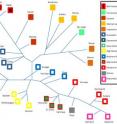Computers match humans in understanding art
Understanding and evaluating art has widely been considered as a task meant for humans, until now. Computer scientists Lior Shamir and Jane Tarakhovsky of Lawrence Technological University in Michigan tackled the question "can machines understand art?" The results were very surprising. In fact, an algorithm has been developed that demonstrates computers are able to "understand" art in a fashion very similar to how art historians perform their analysis, mimicking the perception of expert art critiques. In the experiment, published in the recent issue of ACM Journal on Computing and Cultural Heritage, the researchers used approximately 1,000 paintings of 34 well-known artists, and let the computer algorithm analyze the similarity between them based solely on the visual content of the paintings, and without any human guidance. Surprisingly, the computer provided a network of similarities between painters that is largely in agreement with the perception of art historians.
The analysis showed that the computer was clearly able to identify the differences between classical realism and modern artistic styles, and automatically separated the painters into two groups, 18 classical painters and 16 modern painters. Inside these two broad groups the computer identified sub-groups of painters that were part of the same artistic movements. For instance, the computer automatically placed the High Renaissance artists Raphael, Leonardo Da Vinci, and Michelangelo very close to each other. The Baroque painters Vermeer, Rubens and Rembrandt were also clustered together by the algorithm, showing that the computer automatically identified that these painters share similar artistic styles.
The automatic computer analysis is in agreement with the view of art historians, who associate these three painters with the Baroque artistic movement. Similarly, the computer algorithm deduced that Gauguin and Cézanne, both considered post-impressionists, have similar artistic styles, and also identified similarities between the styles of Salvador Dali, Max Ernst, and Giorgio de Chirico, all are considered by art historians to be part of the surrealism school of art. Overall, the computer automatically produced an analysis that is in large agreement with the influential links between painters and artistic movements as defined by art historians and critiques.
While the average non-expert can normally make the broad differentiation between modern art and classical realism, they have difficulty telling the difference between closely related schools of art such as Early and High Renaissance or Mannerism and Romanticism. The experiment showed that machines can outperform untrained humans in the analysis of fine art.
The experiment was performed by computing from each painting 4,027 numerical image context descriptors -- numbers that reflect the content of the image such as texture, color and shapes in a quantitative fashion. This allows the computer to reflect very many aspects of the visual content, and use pattern recognition and statistical methods to detect complex patterns of similarities and dissimilarities between the artistic styles and then quantify these similarities.
Source: Lawrence Technological University
Other sources
- Computers match humans in understanding artfrom PhysorgWed, 26 Sep 2012, 15:03:05 UTC
- Computers match humans in understanding artfrom Science DailyWed, 26 Sep 2012, 15:00:33 UTC
- Computers match humans in understanding artfrom Science BlogWed, 26 Sep 2012, 13:30:45 UTC
